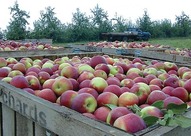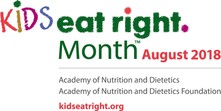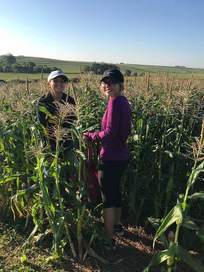 Volume 4, Issue 15, August 14, 2018
|
|
|
|
|
This beautiful bounty of bell peppers was grown by Fairacre Farm in South Dakota.
|
|
Back to School and Back to the Farm
Integrating Farm to School with FFVP
The sun is setting on summer vacation and
teachers and families are preparing for a new school year, but they’re not the
only ones. Nutrition departments across the nation are serving their final
summer meals and gearing up for the start of their school programs. One such program
is the popular Fresh
Fruit and Vegetable Program (FFVP). Started in 2002, the FFVP provides
funding for fresh fruit and vegetable snacks for elementary school students. FFVP
schools have the highest rates of free or reduced-price
lunch eligibility, helping to reach children who may not have access to fresh produce
at home.
The FFVP supports a healthy school environment by
increasing students’ exposure to fresh fruits and vegetables. Schools are encouraged to offer food and nutrition education along with the nutritious snack, making FFVP a perfect
component of your farm to school program. Schools across the country are already working
with local farmers and producers to provide new and exciting produce for their
FFVP. Serving vibrant, fresh, and local produce entices students
to try new fruits and vegetables, while educating them about their local
agricultural community. Read on to learn how districts across the nation are brining the farm to FFVP!
 St. Paul School District, Minnesota
Despite harsh Minnesota winters, the Saint Paul
Public Schools (SPPS) Nutrition Services’ team works throughout the year to
provide fresh fruits and vegetables for their FFVP. To keep the kids interested and the program fun, monthly themes are
developed, such as “Apple Fest” and “Berry Berry Good”. During National Farm to
School month, SPPS takes advantage of fall harvests by featuring Minnesota-grown
products every week. Last October, SPPS FFVP scholars had the opportunity to
devour local green beans, apple slices, butternut squash cubes, and zucchini
coins. The District uses monthly
newsletters to introduce the theme, promote the menu, relay
fun facts, and supply teachers with short classroom activities. The
newsletters identify local items and farms, while offering tidbits of
agriculture education. For example, did you know that the Honeycrisp Apple is
Minnesota’s official state fruit? Saint Paul’s FFVP students did!
|
 Huron Public Schools & Fairacre Farm, South Dakota
Huron Public Schools in South Dakota provides a
variety of local produce for all of their nutrition programs:
FFVP, school meals, and summer lunch, including their summer mobile program!
The District partners with local farmers Kyle and Frances Koehn of Fairacre
Farm to supply fresh produce to the school. Winter can be long in
South Dakota, but with their high tunnel greenhouse and 8-acre farm, Fairacre is able to supply a variety of vegetables even in the coldest of
months. Depending on the season, Fairacre provides tomatoes, carrots, arugula,
snow peas, peppers, okra, and over a dozen other vegetables to the District.
Carol Tompkins, the Nutrition Director at Huron School District, praises Fairacre for their partnership and creativity. “They worked hard at growing year-round for us, which is very tough in
South Dakota, but they made it happen. They built an incredible high
tunnel and used innovative methods to not only grow year-round, but in volume that
we might need. They are the innovators and the sustainers of this FFVP
here…all the credit is really theirs."
|
 Greely-Evans Weld County School District 6, Colorado
At Greeley-Evans Weld
County School District 6 in Colorado, Farm to FFVP is just one component of a
robust farm to school program. Made possible with approval from the Colorado
Department of Education, the District utilized some FFVP funds to purchase
packaging equipment that will allow them to process local products
in-house. Combined with their local procurement strategy, District 6 is looking
to serve even more local produce through FFVP this school year.
The District’s FFVP
schools often implement the “Chef in the Classroom” nutrition education
program, which includes a variety of lessons, such as Farm to School, School
Gardens, Culinary Careers, and Food Waste. Students learn about a number of
different food and agriculture concepts, such as the various parts of a plant,
the benefits of buying local, and how to read a map showcasing Colorado
agriculture. The Program also highlights local foods served in the school lunches,
further tying the classroom to the cafeteria!
The District has also
created an FFVP Education Toolbox for kitchen managers. Managers select a
Toolbox activity to complete throughout the school year. Sample activities
include nutrition-themed worksheets, providing students with recipe cards that
feature FFVP produce, or implementing an in-classroom nutrition education
lesson! Given the District’s focus on serving local items, they aim to
integrate agriculture and farm to school concepts throughout their FFVP
education programs.
Finally, District 6 is working with Colorado State University
(CSU) to understand how farm to school programs impact farm and ranch
profitability, and influence student's consumption of fruits and vegetables, as
well as household's purchases. As part of this work, CSU will be using national
retail scanner data to see if there is a higher prevalence of local purchases
made in regions with more robust farm to school programs. CSU will also conduct a plate waste study to measure students’
preference for locally sourced products as part of the FFVP. Specifically, they will evaluate
preference for local verse conventional bell peppers, carrots, apples, and
cherry tomatoes. CSU received funding for this study from USDA's Agriculture and Food Research Initiative.
From local produce to nutrition education to research,
District 6’s Farm to FFVP is in full bloom!
|
 |
|
Kids Eat Right Month
The month of August is back to school for kids across
the country. The Academy
of Nutrition and Dietetics takes this month to acknowledge the
healthy future we can provide for our nation’s children. Kids Eat Right Month
focuses on the importance of healthful eating and active lifestyles for children and families, featuring
expert advice from registered dietitian nutritionists to help families shop
smart, cook healthy and eat right. The Academy has a variety of online
resources and tools that may help you spread your healthy food message.
|

 Atlantic Public Schools Shows Its "Corny" Side!
Q: Why
didn't anyone laugh at the farmer’s joke?
A: Because
it was too corny!
Iowa is
well known for its fantastic sweet corn, and Atlantic Community School District
in Southwest Iowa wanted to make sure their students had a chance to taste the
good stuff. The district, a USDA
Farm to School Grantee, hosted
the first ever Sweet Corn Day on July 21, 2018.
About 4,000 ears of corn were harvested, shucked, cleaned and processed
for the school’s lunch program. You had better believe it was local – the corn
was grown just 10 miles from the school, and students loved its fresh, sweet
crunch! Twenty-five volunteers helped to make Sweet Corn Day happen, including
students, staff, and community members. This generous support indicated the
community’s widespread approval of Atlantic Public School’s commitment to
expand its farm to school program. For them, sweet corn was just the beginning,
as Atlantic students will enjoy local produce this fall and winter!
|
|
|

Learn more at http://www.fns.usda.gov/farmtoschool or contact us at farmtoschool@fns.usda.gov.
Not yet subscribed to The Dirt? Join us by clicking here.
USDA is an equal opportunity provider and employer. To file a complaint of discrimination, write: USDA, Office of the Assistant Secretary for Civil Rights, Office of Adjudication, 1400 Independence Ave., SW, Washington, DC 20250-9410 or call (866) 632-9992 (Toll-free Customer Service), (800) 877-8339 (Local or Federal relay), (866) 377-8642 (Relay voice users).
|
|
|